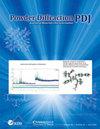Crystal structure of indacaterol hydrogen maleate (C24H29N2O3)(HC4H2O4)
IF 0.4
4区 材料科学
Q4 MATERIALS SCIENCE, CHARACTERIZATION & TESTING
引用次数: 0
Abstract
The crystal structure of indacaterol hydrogen maleate has been solved and refined using synchrotron X-ray powder diffraction data, and optimized using density functional techniques. Indacaterol hydrogen maleate crystallizes in space group马来酸茚达特罗(C24H29N2O3)(HC4H2O4)的晶体结构
利用同步辐射 X 射线粉末衍射数据解决和完善了马来酸茚达特罗氢酯的晶体结构,并利用密度泛函技术对其进行了优化。在 295 K 时,马来酸茚达特罗氢酯在空间群 P-1 (#24) 中结晶,a = 8.86616(9),b = 9.75866(21),c = 16.67848(36)埃,α = 102.6301(10),β = 94.1736(6),γ = 113.2644(2)°,V = 1273.095(7)埃3,Z = 2。传统的 N-H⋯O 和 O-H⋯O 氢键将阳离子和阴离子沿 a 轴连接成链。在非平面的马来酸氢阴离子中存在一个强分子内电荷辅助 O-H⋯O 氢键。阴离子和阳离子之间还有两个 C-H⋯O 氢键。阳离子与阴离子之间形成一个强 N-H⋯O 氢键,同时也是另一个阳离子中一个芳香族 C 的氢键供体。氨基形成两个分叉的 N-H⋯O 氢键,一个是分子内氢键,另一个是分子间氢键。羟基是另一个阳离子的供体。粉末图样已提交给国际粉末衍射中心(ICDD),以便纳入粉末衍射文件™ (PDF®)。
本文章由计算机程序翻译,如有差异,请以英文原文为准。
求助全文
约1分钟内获得全文
求助全文
来源期刊

Powder Diffraction
工程技术-材料科学:表征与测试
CiteScore
0.90
自引率
0.00%
发文量
50
审稿时长
>12 weeks
期刊介绍:
Powder Diffraction is a quarterly journal publishing articles, both experimental and theoretical, on the use of powder diffraction and related techniques for the characterization of crystalline materials. It is published by Cambridge University Press (CUP) for the International Centre for Diffraction Data (ICDD).
 求助内容:
求助内容: 应助结果提醒方式:
应助结果提醒方式:


